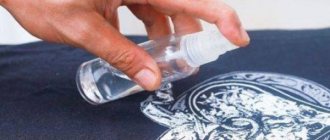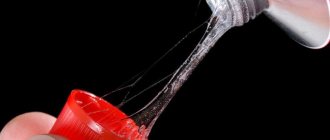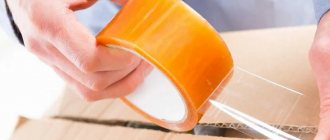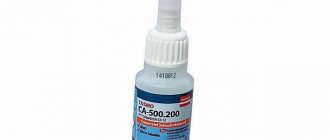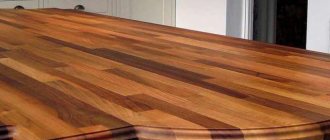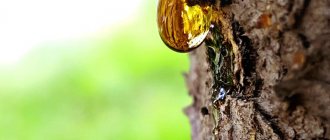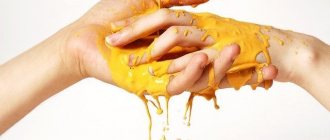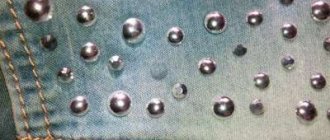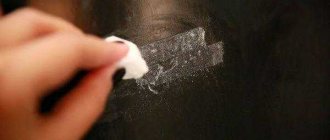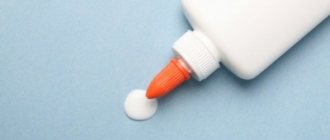What kind of glue did you use?
There are a huge number of types of glue, each with a unique composition. Depending on it, stain removal methods will vary. In everyday life we most often use:
- PVA glue,
- glue stick,
- wallpaper glue,
- silicate glue (liquid glass),
- rubber glue,
- Super glue.
The first three types - with rare exceptions - are water-soluble, and there should be no problems with their removal. We'll look at the rest in more detail.
Soapy water
Regular soap will help remove adhesive stains from materials sensitive to aggressive solvents. Any variety of it will do, it’s especially convenient to use liquid varieties, and if they are unavailable, take a soap bar and grate it. The concentration of the solution does not require special precision - approximately 5th part of a bar per half liter of water.
- Wet the affected area with the prepared solution. For wetting, we use a small cloth, which we leave on the smudge after applying the mixture.
- After about an hour, use a rough cloth to wipe off any remaining dirt from the surface.
If the stains are not completely cleared, the procedure must be repeated.
How to remove silicate glue
postirke.ru
Silicate glue, or liquid glass, is an aqueous alkaline solution of sodium, potassium or lithium silicates. It dissolves in water, so if this mischief maker is responsible for your stained clothes, get the basins ready.
- If the glue has just been spilled, wash the stained areas with warm water: fresh stains will be removed without difficulty.
- If the glue has dried on the skin, the recipe is the same. And you can add a little soap.
- If the glue has dried on your clothes, dissolve 3-4 tablespoons of soda in a liter of water. Soak things in this solution for several hours. Then remove the residue with a brush or scraper.
- If the liquid glass has dried on the glass, there is little chance. Due to the similarity of materials, diffusion begins. The only thing you can do is soak the stain in water for several hours and then scrape it off with a blade. Alas, traces will remain in any case.
Anticlean
This product allows you to wash your hands of dried glue residues. When planning construction or repair activities, understanding the inevitability of contact with glue, use anti-glue, which has gained a high level of popularity. The product is sold in construction stores, so there will be no difficulties with the purchase. Anti-glue will remove glue quickly and painlessly, and it can even be used on your hands. Apply the selected product to the sponge, and then thoroughly wipe the contaminated surface. Subsequently, the stains will be successfully dissolved. Residues can be removed from fabric and natural wood without negative consequences.
By studying modern offers, you will be able to make the right choice regarding the product. A small amount will be needed to remove the adhesive. The effect will be achieved in a few minutes. The procedure requires no effort, which guarantees optimal results. Repeat the procedure if desired, as this will increase the chances of a favorable outcome.
An additional option is a special preparation designed to remove hardened glue. Modern manufacturers note the effectiveness of using the product.
How to remove rubber glue
Rubber adhesive, and in particular the popular “Moment Classic”, is made on the basis of rubber and hardens due to evaporation from the solvent composition. Long-term soaking in water, exposure to acetone, gasoline or kerosene will help remove glue. If the stain is fresh, wash it quickly before it hardens.
How to Remove Rubber Glue from Leather
- Try washing dried glue off your hands with plenty of warm soapy water.
- If this does not help, use moisturizers: vegetable oil, fatty cream or Vaseline. Rub any of these substances into the skin until the glue begins to clump.
- If this does not help, we move on to heavy artillery. Apply acetone (nail polish remover) to a cotton swab and apply to the stain for a few minutes until the glue softens. Be careful to use this method only on small areas of skin.
Advice for the future: do not unscrew the tube cap with your teeth if you do not want your lips to stick together.
How to Remove Rubber Glue from Clothes
- Soak the items for several hours in water with laundry soap (a tablespoon of grated soap per liter of water). If the glue has not become embedded in the fibers of the fabric, this method will be sufficient for complete cleaning.
- Try removing particularly stubborn stains with acetone or gasoline. Apply a small amount of liquid to a cotton swab and treat the stains. After this, wash the item as usual. Acetone and gasoline can discolor or damage fabric. Test their effect on a small area before use.
- If you need to remove glue from silk or wool, you will need a more gentle cleaning method. Add citric acid (20 grams) or a tablespoon of 70% vinegar essence to water (100 ml). Apply the solution to the stains, and then wash in the washing machine on the delicate cycle.
- Don't have anything suitable at hand? You can try the critical temperature method: heat the fabric with a hairdryer, and then place it in the freezer. The structure of the glue will collapse, it will become brittle, and it can be scraped off with a knife.
Removing traces of labels and stickers
In the same way that stains from rhinestones are removed, it is easy to remove glue from a sticker. One of the very first methods that you need to use is to remove the stain using fat, that is, any vegetable oil. In this case, use olive, sunflower, or any cosmetic oil intended for caring for the skin of the face or hands. Vegetable oil is applied to the area where the glue is located and left for one hour. Care should be taken to ensure that the fat does not get onto other areas of the fabric where there are no traces of glue. After 60 minutes, begin to remove traces of vegetable oil. This is easy to do if you use dishwashing detergent. It emulsifies fat well. In this way, the adhesive trace that remains after the price tag is pasted on the clothes is removed.
As you can see from the information described in this article, it is quite possible to deal with glue stains. The main thing is not to delay the solution to the problem, but to remove the glue immediately after it gets on the fabric. It is also now clear what to do if labels are stuck on clothes that leave marks. It is important to remember: the faster we wash off dirt, the greater the chance of saving the item.
How to remove superglue
Superglue is a synthetic cyanoacrylate based adhesive. It hardens upon contact with water and does not dissolve in ethanol, so baths and alcohol compresses are powerless here. To remove superglue, you will need dimethyl sulfoxide (don’t be alarmed, it can be found in any pharmacy under the trade name “Dimexide”) and acetone.
aquagroup.ru
If the stain is fresh, do not wash it with water, quickly look for nail polish remover. Acetone perfectly dissolves superglue in liquid form. With a frozen one, everything is more complicated.
How to Remove Super Glue from Skin
- Leather is a more pliable material than hardened glue. Soften it with cream or oil: this will reduce the adhesion of the stain to the epithelium.
- Make a scrub: mix a spoonful of fine salt, sugar or ground coffee with a small amount of liquid soap and gently rub the stained areas.
- As a last resort, file off the glue layer with a nail file. This method is only suitable for thick skin on the fingers.
- If the glue stain on the skin does not cause any inconvenience, just forget about it for 2-3 days. The sebaceous glands themselves will push it off the surface.
How to Remove Super Glue from Clothes
- Apply a little acetone or Dimexide to the dirt using a cotton swab. Leave for 20-40 minutes, and then wash the item as usual. First test the tissue's reaction to these substances in a small, inconspicuous area.
- The critical temperature method will also help. Heat the fabric with a hairdryer, and then put it in the freezer for a couple of hours. When superglue hardens, it turns into a kind of plastic and becomes brittle so that it can be scraped off.
Ice
It is recommended to put the item that has glue on it in the freezer. The cold will take effect, after which the adhesive substance can be removed. Wait a couple of hours, wanting to achieve a decent effect. If you can't put the item in the refrigerator, use an ice pack. The glue will become brittle due to the influence of cold, as a result of which it can be easily scraped off. If you want to achieve decent results, use a special scraper that allows you to successfully remove the layer of glue.
Mineral motor oil
The use of such products implies that the surface being treated is resistant to oil components. Parts painted with polyurethane or acrylic paints and varnishes may lose their protective layer. Unpainted wood can be safely cleaned with oil. The process is quite simple: apply oil to the glue marks and wait half an hour. During this time, the adhesive film will soften and peel off at the edges, after which it can be removed from the affected area without much difficulty.
Mechanical cleaning of wooden products
The easiest and fastest way to remove superglue from unpainted wood is to sand it. This option has only positive aspects: it is non-toxic, it only takes a couple of minutes, the stain will disappear without a trace, there is no need to use cleaning agents or solvents. The only tool needed to successfully remove adhesive stains is fine-grained sandpaper. The finer the abrasive on the sandpaper, the smoother the wooden surface will be subsequently.
Ammonia and dish gel
A mixture of ammonia and dishwashing detergent will help remove adhesive stains from glass.
- Mix the above products in equal quantities.
- We wet a cloth or sponge in the resulting mixture and apply it liberally to the stain.
- Leave for an hour, and to prevent the treated area from completely drying out, periodically moisten it with a sponge soaked in the mixture.
- Using a thin, sharp object, carefully scrape off the remaining glue (a razor blade fixed in an eraser will do).
- We moisten a microfiber cloth with ammonia and rub the area to be cleaned.
This method will help eliminate glue and similar products.
Medical alcohol
It is especially effective in cases of contamination from BF brand glue, since this product is made on an alcohol basis. In cases where it is necessary to get rid of traces of superglue, achieving the desired result will require a little more time and effort, but the task will be solved. Sequencing:
- Soak a cloth in 96% rubbing alcohol and wipe the stain.
- We do this until the dirt softens and its edges begin to peel off from the surface.
- We remove the residues mechanically; if any fragments cannot be cleaned, re-wet them with alcohol, and then wipe the treated area with warm water.
Acetone, solvent or white spirit
Second glue is easily corroded by solvents. The process is as follows:
Add a teaspoon of solvent to a tablespoon of toothpaste and stir thoroughly;
- Apply the prepared mixture to the stain and leave for 15 minutes.
- Using a soft toothbrush, we try to wipe away traces of glue; to do this, rub the dried mixture in a circular motion.
- Use a plastic spatula to remove any remaining dirt, then wipe the surface with warm soapy water.
Aggressive cleaning liquids should be used with caution, after testing on an inconspicuous area, this is especially true for acetone.
Household or car windshield wiper
This method will work for minor glue stains, especially with adhesives that contain alcohol.
- Apply liquid to the stain directly from the spray bottle that comes with containers containing glass cleaning products.
- After a couple of minutes, wipe with a hard rag; if you cannot completely remove the glue, repeat the procedure.
